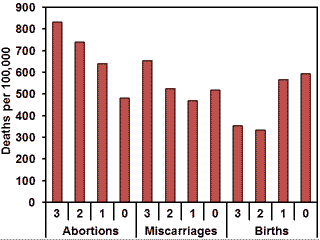Is Abortion or Childbirth Safer for a Woman?

Introduction
Early term abortion tends to have a low mortality rate. Childbirth in developed countries also tends to have a low mortality rate for women, although the abortion industry has claimed it is higher than having an early abortion.1 The problem with the statistics, at least in the United States, has been that abortion statistics are not reported in all states for the sake of "privacy," even though these statistics could easily be anonymized. In reality, the abortion industry does not want statistics reported and has colluded with the legislatures of liberal states to block such reporting. Likewise, death certificates often do not report deaths due to complications of abortion. However, in certain countries, all health-related statistics and mortality statistics are maintained by the government and available for analysis. The statistics from all women born between 1962 and 1993 in Denmark were analyzed to determine the mortality rates of women following childbirth, miscarriage or abortion, finding that abortion was, by far, more likely to result in death.2
Danish study
A study population consisted of over all women (over one million) born in Denmark born between the years 1962 and 1993, who did not die before the age of 16 years or before January 1980, which was the start date for recording of deaths. Of these women, 5137 deaths were recorded between January 11, 1980 and December 31, 2004, with an average age at death of 27.4 years. Since the study analyzed all women in the study population and all pregnancy outcomes, the study provided the first reliable comparison between mortality rates for women who give live birth compared to those who undergo induced abortion or suffer miscarriage.3
Study results
The most surprising result of the Danish study was that women who never became pregnant had the highest risk of death—fully six times higher than those who gave birth.2 However, as was pointed out in the study, women who die in their twenties have a low probability of giving birth. The comparison of mortality rates based upon pregnancy outcome for the entire population is reproduced from Table 3 in the figure to the right. The data shows that women who experienced either induced abortion or spontaneous miscarriage had much high mortality rates compared to those who gave birth, generally in a dose-dependent manner (more abortions/miscarriages were associated with a higher mortality rate). The results are highly significant, with p values of less than 0.001.
The study did not examine the cause of death, since this would have required examining each of the over 5,000 deaths on on individual basis. So, the study does not show that having an induced abortion results in death, but only that the number of abortions a woman has was associated with increased mortality. It is possible that women who undergo abortions tend to lead a riskier lifestyle, resulting in a higher than average mortality rate. However, the correlation of number of abortions with increased mortality is strong evidence that abortion itself is somehow linked to an increased risk of death. Regardless of the cause vs. effect question, the study shows quite clearly that the idea that abortion is safer than childbirth is a myth.
Conclusion 
Abortion providers have claimed for years that abortion is safer than childbirth, providing a key selling point for their services. However, the first comprehensive examination of the claim using real data from an entire population of women has shown the claim to be false. Women have an up to two-fold increased risk of dying after having one or more induced abortions. The fact that there was a correlation between the number of abortions and the mortality rate suggests that abortion was somehow responsible for the increased risk of death. Although abortion is the "easy way" out of an unplanned pregnancy, we recommend getting in contact with a crisis pregnancy center or adoption center to give your baby a chance at life. So, if you are pregnant and can't keep the baby, take the higher moral ground and give her a chance to grow up in a loving home.
Related Pages 
 Science and Abortion- The Scientific Basis
for a Prolife Position
Science and Abortion- The Scientific Basis
for a Prolife Position- Why Pro-Abortion Is Anti-Science
- Confessions of a Pro-Life Atheist - Why Abortion Rights is not a Religious Question
- D & X (Partial Birth) Abortions
- "After Birth Abortion": Infanticide (Killing Babies) is Okay According to Doctors
- Modern Eugenics: How Abortion is Getting Rid of 'Undesirables'
- Testimony of Gianna Jessen, Hearing on H.R. 4292, the "Born-Alive Infants Protection Act of 2000", House Judiciary Subcommittee on the Constitution, July 20, 2000
- Testimony of Jill L. Stanek, RN, Hearing on H.R. 4292, the "Born-Alive Infants Protection Act of 2000", House Judiciary Subcommittee on the Constitution, July 20, 2000
- Men are Responsible for the Abortion Problem
References 
-
NARAL Pro-Choice Wisconsin : About Us : Frequently Asked Questions (FAQs)
"Legal abortion is one of the safest surgical procedures available today, much
safer even than childbirth."
What Happens During an Abortion - In-Clinic Abortion Cost, Planned Parenthood. "The risk of death from childbirth is 11 times greater than the risk of death from an abortion procedure during the first 20 weeks of pregnancy." - Coleman PK, Reardon DC, Calhoun BC. 2012. Reproductive history patterns and long-term mortality rates: a Danish, population-based record linkage study. Eur J Public Health doi: 10.1093/eurpub/cks107.
- The reproductive history data pertaining to the oldest women sampled may have been missing a few outcomes, because these women were 15 years old in 1977 when miscarriage data first became available, and 11 years old when induced abortion data were initially recorded. Although miscarriages before age 15 years and induced abortions before age 11 years are decidedly rare events, if they did occur they are not reflected in the database.
http://www.godandscience.org/doctrine/abortion_or_childbirth_safer.html
Last updated September 25, 2012



